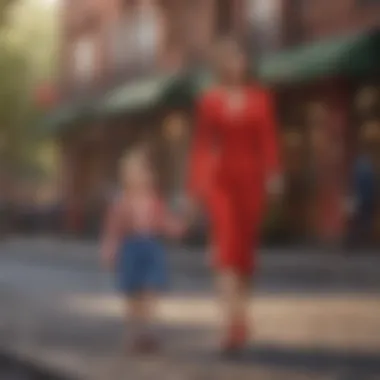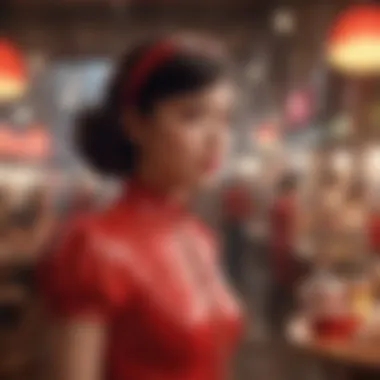The Cultural Impact of 'Turning Red' in Disney Animation


Intro
Disney's animated film 'Turning Red,' directed by Domee Shi, offers insightful observations about adolescent identity and cultural representation. This film is set against the backdrop of Toronto in the early 2000s, and follows a thirteen-year-old girl named Mei Lee. As she grapples with her cultural identity and the societal pressures of growing up, the film opens a dialogue on themes that resonate widely among audiences today.
By exploring Mei's life as she transitions from childhood to adolescence, the narrative delves into complex elements, such as familial expectations, personal identity, and the intricate dance of peer relationships. This article will dissect various aspects of 'Turning Red,' analyzing how these resonate in modern culture and particularly among women.
The significance of this exploration rests not only in the film's critical reception but also in its potential as a catalyst for discussion on broader societal issues including gender, intersectionality, and personal growth.
Key Trends
Representation and Identity
'Turning Red' shines a light on representation in animation, centering around Asian characters in a manner that feels authentic and relatable. This film contributes to a larger trend towards inclusivity in modern animation, moving away from stereotypical portrayals. It encourages discussions about cultural identities and the various challenges that accompany them, particularly for young girls.
The film serves as a reflection of diverse experiences, allowing audiences to engage with narratives that are often overlooked in mainstream media.
Familial Dynamics
The portrayal of Mei’s relationship with her family is another crucial element. 'Turning Red' portrays the dynamics of a close-knit family, emphasizing how cultural expectations shape these relationships. This trend of exploring familial ties in animation speaks to many viewers who face similar pressures in their own lives.
Gender and Adolescence
The film also tackles gender through its focus on menstruation and growing pains, representing a topic that has historically been stigmatized. The candid depiction of Mei's experiences surrounding these themes provides a valuable representation and fosters understanding around issues of womanhood. This aligns with a growing trend in media to discuss topics that resonate with female audiences, encouraging open dialogue.
End
In examining the cultural impact of 'Turning Red,' it becomes clear that the film plays a part in forming new narratives around identity, family, and gender. Its relevance reflects ongoing societal shifts towards understanding diverse experiences and the necessity of representation in animated media. By engaging with these themes, 'Turning Red' provides a meaningful addition to Disney's animated portfolio, inviting reflection among viewers from various backgrounds.
Preamble
The release of Turning Red represents a significant moment in Disney's animation landscape. This film stands out not only for its artistic merit, but also for the layers of cultural discourse it evokes. The film addresses important themes such as coming of age, family dynamics, and cultural heritage, all of which resonate deeply with audiences today. By exploring these subjects, the film opens a dialogue about adolescent identity in a contemporary context.
One of the primary elements to consider is how Turning Red challenges traditional narratives within Disney's animated portfolio. The protagonist, Mei Lee, embodies the challenges of growing up in a multicultural environment. This duality of experience—straddling the cultural expectations of her Chinese heritage while navigating the complexities of modern adolescence—provides a unique lens through which audiences can examine their own identities. This perspective is critical as it cultivates a more inclusive and diverse representation in mainstream media.
Moreover, the film contributes to ongoing discussions about gender roles and intersectionality, which are vital in today's society. The portrayal of young female characters breaking stereotypes sets a new precedent for animation aimed at children and young adults. As such, Turning Red not only entertains but also educates viewers about the intricacies of their cultural and personal narratives.
The cultural impact of Turning Red is profound. It encourages conversations around family, identity, and self-acceptance. By providing a nuanced portrayal of a young girl's struggles, the film offers a sense of validation for many who experience similar conflicts. This article will delve into these themes and more, illustrating why Turning Red is a milestone in Disney's animation history, and its relevance goes beyond mere entertainment.
Overview of 'Turning Red'
Understanding the context of Turning Red is essential for grasping its cultural significance in Disney's animation landscape. This section outlines the film's premise, its key themes, and production insights, all of which underscore its role in contemporary discussions about identity, culture, and family.
Premise of the Film
Turning Red tells the story of Mei Lee, a 13-year-old girl grappling with the rapid changes of adolescence. The plot thickens when she discovers that she transforms into a giant red panda whenever she experiences strong emotions. This premise strikes a chord with audiences, particularly adolescents, because it symbolizes the chaotic feelings that accompany the transition into teenage years. The film cleverly intertwines humor and heartfelt moments, reflecting universal themes that resonate across different cultures and ages.
Key Themes Explored
-#### Coming of age The coming-of-age aspect of Turning Red focuses on the challenges many young individuals face during puberty. Mei's journey represents the emotional turmoil and self-discovery that define adolescence. This theme is a relevant choice for the article because it illustrates how the film captures the complexities of growing up, making it relatable for viewers of all ages. Moreover, the filmmakers design Mei's transformation as a metaphor, emphasizing that understanding one's emotions is crucial during this stage of life.


-#### Cultural heritage Cultural heritage plays a vital role in shaping the film's identity. Mei's Chinese-Canadian background is integral to the story, providing viewers with insight into dual cultural experiences. This theme is advantageous for the article since it highlights how Turning Red elevates personal narratives within the broader Disney canon, promoting representation. The unique feature of this cultural lens offers the audience a fresh perspective, helping to bridge cultural divides while celebrating diversity.
-#### Family dynamics The aspect of family dynamics is prominent in Turning Red. Mei's relationship with her mother adds depth to the film, revealing the pressures of expectations from both family and society. This theme is crucial for our article as it illustrates the delicate balance that teens navigate while trying to assert their independence. The film depicts the struggles and triumphs of this relationship, underlining the importance of support and communication between generations.
Production Insights
The production of Turning Red showcases an innovative approach to animation and storytelling. Directed by Domee Shi, the film stands out for its distinctive visual style and character design. The animation techniques used express the emotional fluctuations experienced by Mei. Furthermore, the film includes input from diverse voices within the creative team, ensuring authenticity in the portrayal of cultural aspects. This inclusion enriches the narrative and reflects a shift within Disney towards more inclusive storytelling practices.
These production insights enrich the understanding of Turning Red, demonstrating how the film not only entertains but also addresses complex social issues.
Character Analysis
Understanding the characters in Turning Red offers rich insight into the film's cultural significance. Each character is carefully designed to reflect particular themes that resonate strongly with audiences. The character dynamics explore the nuances of adolescent identity, family relationships, and cultural heritage. This section aims to delve deep into Mei Lee, the main character, and highlight the supporting cast's roles. Analyzing these characters allows us to comprehend how they symbolize larger societal issues and cultural dialogues, thus enhancing our grasp of the film's impact.
Mei Lee: A Symbol of Adolescence
Mei Lee stands as a poignant representation of the struggles faced during the transition from childhood to adulthood. She embodies the quest for identity that many adolescents experience. Throughout the film, Mei’s journey mirrors that of countless young individuals navigating puberty, familial expectations, and cultural obligations. Her character is marked by a blend of innocence and emerging independence, which makes her relatable to viewers of various backgrounds.
Mei’s transformation into a red panda serves as a metaphoric representation of her emotional turmoil. This unique aspect demonstrates how external perceptions can clash with internal truths—a reflection of the adolescent experience. The iconic scene where Mei first transforms captures her overwhelming feelings of pressure and confusion. It effectively communicates the essence of growing up, making her character relatable and compelling.
Supporting Characters and Their Roles
Mother-Daughter Relationship
The mother-daughter relationship between Mei Lee and her mother, Ming, is central to the narrative. This dynamic illustrates the themes of generational conflict and cultural expectations. Ming represents traditional values and the weight of familial heritage, while Mei seeks autonomy and self-expression. Their interactions highlight the push and pull of love and expectation.
This relationship is crucial for understanding broader implications of family dynamics in cultural contexts. A notable characteristic is Ming's protective nature, which reflects a common cultural narrative among immigrant families. The portrayal of this bond offers depth, making it a relevant choice for this article. The unique challenge is finding the balance between respect for tradition and the pursuit of individual desires. This tension enriches the story, appealing to viewers who share similar experiences of navigating close familial relationships.
Friendship Dynamics
The depiction of friendship among Mei and her peers is another vital aspect of the film. Their bond showcases the importance of supportive relationships during formative years. Mei’s friends bring different perspectives and experiences, enriching her journey of self-discovery. The friendship is characterized by loyalty and acceptance, emphasizing the value of community.
This choice is significant as it resonates with audiences, fostering discussions about the impact of friendships in adolescence. The unique feature of these friendships is how they offer a safe space for Mei to explore her identity. While these relationships provide comfort, they also highlight the pressures of social acceptance, offering a balanced portrayal of the adolescent experience.
Cultural Influences
Cultural influences in Turning Red play a pivotal role in shaping the characters and storyline. The film draws heavily on Mei's Chinese-Canadian background, integrating cultural practices and family traditions into the narrative. This representation acknowledges the importance of cultural identity in personal development.
Highlighting cultural influences enriches the storytelling by providing context that many viewers can relate to. The vibrant depiction of cultural elements, such as family gatherings and celebrations, reinforces a sense of belonging. However, it also brings forth the challenges of balancing one's heritage with the pursuit of individual aspirations. This unique aspect adds complexity to the narrative, making it beneficial to discuss in this article.
Animation Style and Aesthetic
The visual presentation of a film plays a critical role in creating a lasting impression. In Disney's 'Turning Red,' the animation style and aesthetic are not merely decorative; they are integral to the narrative itself. The film employs vibrant colors, expressive character designs, and innovative techniques that resonate with both younger audiences and adults. This section aims to explore how these elements contribute to its cultural impact.
Visual Narrative Techniques
The animation in 'Turning Red' utilizes various narrative techniques that enhance storytelling. It employs dynamic character movements and exaggerated features to convey emotions effectively. For instance, everyone's favorite red panda transformation serves as a physical manifestation of Mei’s internal struggle. The fluidity of the animation allows for nuanced expressions that go beyond dialogue, creating a deeper connection between the audience and the characters.
Additionally, the film strategically uses movement to guide the viewer's attention. Key scenes shift rapidly from one location to another, reflecting the chaotic nature of adolescence. This keeps audiences engaged while also driving home the point of a transformative life phase. These techniques result in a visually rich experience that captivates viewers.
Color Palette and Symbolism


In 'Turning Red,' the color palette is not only eye-catching but also carries significant meaning. The filmmakers chose bright reds and soft pastels to represent the duality of Mei's life. The vibrant reds symbolize her burgeoning identity and emotions, while the softer hues portray her youthful innocence and connection to family.
By utilizing bold contrasts, the animation visually distinguishes moments of clarity and chaos in Mei's life. This coloring strategy evokes emotional responses, helping audiences to empathize with her journey of self-discovery. Notably, colors like red are often associated with passion and energy, which complements the film's themes of growth and girlhood.
"The combination of animation style and color reflects key aspects of adolescence, making the film relatable to many."
Thus, the animation style and aesthetic of 'Turning Red' not only enhance the visual experience; they amplify the film’s key themes and emotions. Through intentional choices in visual narrative techniques and a thoughtful color palette, the film creates a compelling representation of adolescent life, contributing to its persistent impact on contemporary culture.
Impact on Gender Representation
The impact of gender representation in media cannot be understated, particularly in animated films where messages can shape youth perceptions. Disney's Turning Red plays a significant role in challenging traditional gender narratives through its complex portrayal of female characters. This film acknowledges the struggles of adolescence while also presenting empowered female characters that resonate with viewers. The representation of girls' experiences will influence how society views gender roles and expectations.
Feminine Identity and Agency
Turning Red authentically explores feminine identity by focusing on Mei Lee, a young girl on the cusp of adolescence. Her journey centers around navigating the pressures of growing up, family expectations, and personal identity. Unlike many traditional animated films, this narrative emphasizes Mei's autonomy, showcasing her decisions and agency. The portrayal affirms that girls are not simply secondary characters; they can take charge of their stories and destinies.
The film also encourages discussions surrounding hormonal changes and emotional responses that come with growing up. By presenting Mei's transformation as a literal physical manifestation of her feelings, the film normalizes the complexities of puberty. This depiction helps girls see themselves in their struggles, promoting a healthier understanding of what it means to grow up.
Furthermore, the relationships Mei has with her friends further magnify her agency. They support each other in exploring their identities, emphasizing the importance of friendship in forming a solid feminine identity. This presentation is critical; it shows that female characters can be multifaceted and powerful together, without resorting to competition.
Conversations Around Intersectionality
In addition to feminine gender roles, Turning Red opens up conversations about intersectionality, illustrating that the experience of growing up is not uniform. Mei is not just Asian; she is a Canadian-Chinese girl, and her cultural background significantly shapes her experiences. The film does not shy away from depicting these cultural nuances, leading to a richer narrative.
This layered storytelling allows for a broader discussion on the influences of race, culture, and tradition on gender identity. Though Mei navigates her Asian heritage, her experiences are relatable to many.
"Cultural influences add complexity to the narratives of female characters, especially in coming-of-age tales."
By integrating these themes, the film connects with diverse audiences. Women of various backgrounds can see facets of their stories reflected, fostering a sense of belonging. The film stimulates important conversations about how intersectionality shapes one's identity, encouraging viewers to explore their own experiences through this lens.
Audience Reception and Critique
Understanding the audience reception and critique of Turning Red is crucial to grasp the film's cultural impact within Disney's landscape. This section provides insight into how modern viewers interpret the film's various themes and characters. The film's reception has highlighted the significance of representation and identity in animation, especially for adolescent audiences.
The discussions surrounding Turning Red reveal a duality in its reception. On one hand, it has been praised for its innovative portrayal of a young Asian girl navigating the challenges of adolescence. On the other hand, it has faced scrutiny for addressing themes that some viewers find controversial or uncomfortable.
Critical Acclaim and Public Response
Turning Red has received high praise from critics and audiences alike. The film's ability to connect with diverse audiences stems from its exploration of complex themes such as growing pains, cultural identity, and family relationships. Notably, the unique visual style and engaging storytelling have also contributed to its overall success.
Key Highlights:
- The film successfully reflects contemporary issues of adolescence.
- Critics have noted the authenticity in character development.
- Audience reactions demonstrate a strong emotional connection to the protagonist, Mei Lee.
"Turning Red brings forth an essential dialogue about adolescence and cultural identity that resonates with many viewers today."
This acclaim has solidified Turning Red as a contemporary classic in Disney's portfolio. It showcases the studio's shift toward more inclusive narratives, which can enrich the viewing experience for all demographics.
Controversial Perspectives


Despite its acclaim, there are elements of Turning Red that have sparked debate and led to divided opinions among audiences. These controversial aspects can provide valuable insights into prevailing cultural issues.
Censorship Issues
Censorship has emerged as a key point of contention surrounding the film. Content that challenges traditional views often faces pushback. In regions where cultural taboos exist, Turning Red has encountered censorship, which limits its availability and distorts its message.
This aspect is important because it raises questions about freedom of expression in artistic media. The key characteristic of censorship in relation to this film is how it reflects societal discomfort with themes related to adolescence and cultural differences. As such, it becomes a relevant and popular topic for discussion in this article, opening doors to conversations about the implications of censoring artistic works and the potential loss of diverse voices in cinema.
Generational Divides
Another significant aspect of Turning Red that has created discussion is the generational divide in its interpretation. While younger audiences may resonate with Mei's struggles for identity and acceptance, older generations might view these themes through a different lens, often rooted in more traditional values.
The key characteristic of generational divides lies in the contrasting perceptions of the film's message. This divide is important as it highlights the evolving nature of societal norms and expectations regarding adolescence. It also allows for an examination of how these generational perspectives can lead to fruitful discussions, which can either bridge gaps or create more tension.
Ultimately, both censorship issues and generational divides are not mere contentions or critiques. They serve as pathways to understanding how Turning Red both stimulates and reflects broader cultural conversations within the context of Disney's animation legacy.
Connection to Broader Disney Narrative
Disney films have historically served as a cultural touchstone, bridging generational divides and influencing public perceptions. The release of 'Turning Red' marks a significant chapter in Disney's animated legacy. The film not only presents a fresh narrative perspective but also exemplifies Disney's evolving approach to storytelling. In this section, we will explore the evolution of Disney's animated stories and the sustainability of its cultural relevance. These aspects underscore how 'Turning Red' fits into the broader Disney narrative.
Evolution of Disney’s Animated Stories
Disney's storytelling has undergone considerable transformation since its inception. Initially, the focus was primarily on fairy tales and classic myths. Films such as 'Snow White and the Seven Dwarfs' and 'Cinderella' exemplified a formula steeped in traditional values. However, over the decades, the scope has widened significantly to include diverse voices and contemporary themes.
'Turning Red' plays a crucial role in this evolution. It centers around a Chinese-Canadian teenage girl navigating the complexities of adolescence while also embracing her cultural heritage. This focus on multiculturalism allows young viewers from different backgrounds to see themselves represented in mainstream media. The film's portrayal of intersectional identities sets it apart from earlier Disney films, positioning it as a reflection of our increasingly diverse society.
With this evolution, Disney has also embraced more intricate character development. In 'Turning Red,' characters are multi-dimensional, serving as representations of both individuality and collective cultural experiences. This change signifies a shift from the simplistic character archetypes of the past to more relatable characters who mirror real-world experiences and challenges.
Sustainability of Disney’s Cultural Relevance
In a fast-changing entertainment landscape, maintaining cultural relevance is essential for any media conglomerate. Disney manages to achieve this through innovation and sensitivity to audience expectations. 'Turning Red' illustrates how contemporary themes can resonate powerfully with audiences. These include issues of gender identity, family dynamics, and the process of growing up, which are universally relevant yet culturally specific.
The film's success can be attributed to Disney's understanding of socio-cultural dialogue. By tackling themes pertinent to today's youth, 'Turning Red' connects with audiences on multiple levels. It encourages discussions around topics such as identity and belonging, which are critical in today's context of multiculturalism.
Furthermore, the film exemplifies Disney's commitment to inclusivity. This approach is not merely a marketing strategy; it reflects a genuine effort to align with the values of current and future generations.
"The enduring power of Disney animation lies in its ability to capture the spirit of the times while evolving its narratives to meet audience expectations."
Finale
In examining the cultural implications of 'Turning Red,' we come to recognize the profound effect it has on contemporary animation and societal narratives. The film not only incorporates relatable themes but also challenges traditional storytelling in animation. By showcasing the complexities of adolescent identity and the struggles of cultural heritage, it encourages audiences to embrace their individuality.
Future of Animation at Disney
The future of animation at Disney may very well reflect the ethos found in 'Turning Red.' Here are some considerations:
- Increase in Diverse Narratives: Disney seems poised to embrace stories that resonate with a wider demographic, allowing for a deeper exploration of various backgrounds.
- Focus on Realism: As seen in 'Turning Red,' a transition toward more realistic portrayals of adolescence may become more common, engaging viewers who seek authenticity in storytelling.
- Emphasis on Representation: Future Disney films may prioritize representation, ensuring that underrepresented voices are heard and celebrated, mirroring the film’s successes.
The animation landscape may shift towards inclusion and emotional depth, aiming to reflect the society we live in today.
Legacy of 'Turning Red'
'Turning Red' stands as a landmark film within the Disney canon, influencing both audiences and creators alike. Its legacy will likely unfold in multiple dimensions:
- Cultural Conversations: It opens the door for discussions regarding the intersectionality of cultural identity and generational differences. By doing so, it creates an environment for healthy dialogue and understanding.
- Influence on Future Projects: The film’s unique approach to storytelling may inspire future Disney projects, steering them towards topics of adolescence and cultural exploration with a fresh lens.
- Impact on Young Audiences: For many young viewers, the film becomes a mirror reflecting their own life experiences. This connection fosters identity and promotes self-acceptance, which is crucial in a world where cultural narratives often feel one-dimensional.
'Turning Red' not only entertains but also empowers, leaving a lasting imprint on the hearts and minds of its audience.



